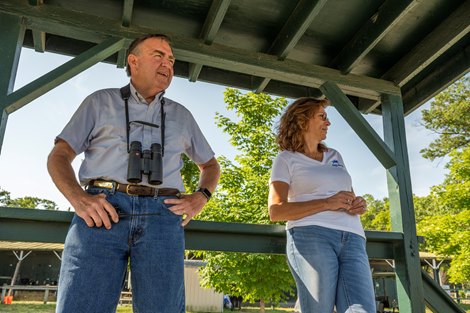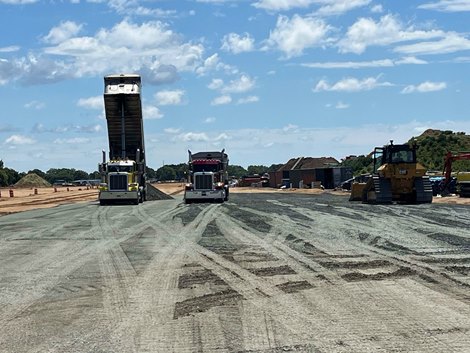The New York Racing Association provided a window into the future of downstate racing July 1 when it announced that the main dirt track at the new Belmont Park will mirror the surfaces at Saratoga Race Course and that winter racing will be conducted for approximately three months on a new all-weather track when the Elmont, N.Y., facility reopens in 2026.
In deciding on a new dirt surface and the exclusive use of the all-weather track in winter months, NYRA officials placed an emphasis on safety and the lower equine fatality rates on both surfaces.
In response, the New York Thoroughbred Horseman’s Association voiced displeasure over the prospect of racing solely on a synthetic surface in the winter.
“At its core, our vision for the new Belmont Park is centered around modernizing racing and training facilities in ways that will ensure the sport’s continued success and future growth,” Dave O’Rourke, NYRA’s president and CEO, said. “NYRA has closely tracked the evolution and application of synthetic surfaces, and the relevant data unequivocally supports a shift to the all-weather surface during the winter months.
“Together with the renovated main track and two new turf courses, Belmont Park will provide a multitude of quality options for both training and racing throughout the year. We will continue to work closely with New York’s horsemen and breeders to ensure a smooth transition as the new facility takes shape.”
NYRA said the rebuilt main track at Belmont will consist of a limestone base with a clay pad below the dirt mixture of sand, silt, and clay, which is the same composition as the main track and Oklahoma training track at Saratoga, which have been remarkably safe in recent years.
Last year, according to the Equine Injury Database, there were just 1.02 equine deaths per 1,000 starts on the main track at Saratoga, which was below the national average of 1.43 and the marks of 2.17 at Aqueduct Racetrack and 2.38 for Belmont Park’s previous surface.
Saratoga’s EID figures of 1.28 in 2022 and 0.58 in 2021 were also below the national norms of 1.44 and 1.51, respectively. In addition, there have been no fatal injuries during 2024 training at Saratoga’s main track and Oklahoma after a combined 2,132 timed works through June 13.
There were also no fatal breakdowns at Oklahoma last year with 9,164 works over the dirt and turf tracks.
“The harmonization of NYRA’s dirt surfaces is yet another important equine safety measure in New York,” said Andrew Offerman, NYRA’s senior vice president of racing and operations. “Aligning the composition of the Belmont main track with both dirt surfaces at Saratoga will further NYRA’s ability to conduct world-class dirt racing in the spring, summer, and fall.”
NYRA is also renovating and expanding Belmont’s Widener and inner turf courses, adding running lanes, modern drainage, and a state-of-the-art irrigation system serviced by a new infield irrigation pond and on-site pump station.
Rendering of New Belmont Park
“This is a hugely significant project in NYRA’s history, and it’s an honor to be a part of something that will push the sport into the future,” said NYRA executive vice president for operations and capital projects Glen Kozak. “Our goal is to provide the highest quality and most consistent surfaces in racing, and we have assembled a team that will make that goal a reality.”
In contrast, NYTHA president Tina Bond said her group was “disappointed” and disheartened by NYRA’s moves, saying the wintertime use of the all-weather surface, which turf horses generally handle better than dirt horses, would create a problem for trainers, owners, and breeders with horses that have dirt pedigrees.
More on NYRA’s Winter Racing Plans
Bond said NYTHA supported a main track without the clay pad, which can freeze in the winter, that would be much like the surface at Aqueduct, which will close when Belmont reopens.
“The horsemen would prefer to have dirt racing and synthetic racing for the winter meet,” Bond said. “We proposed that the main track would have a limestone base that could be treated in the winter months. The horsemen are disappointed that NYRA came to this conclusion and they felt very strongly as a whole about it. We know at times in the winter you would have to use the Tapeta, but we would like to have options. To not have options is disheartening.”
Though the Tapeta surface will not be used in winter until December 2026, at the earliest, Bond said the move will impact breeders who have stallions with strong dirt pedigrees and could cause some stables to leave New York.
“It’s hard when you are a breeder and you produce dirt horses who have no options at NYRA in the winter,” said Bond, who heads a racing and New York State breeding operation run by her husband, trainer James Bond. “If you are a breeder and you have a five- or four-year plan to get horses to the track, you are impacted by doing this in two years. If a breeder’s foals are from dirt stallions and mares, they will be in trouble.”

Jim and Tina Bond at the Saratoga Race Course
Bond said a survey of NYTHA members found 87% were in favor of having a limestone base without the clay pad and 60% would race less or not all in winter on an all-weather surface.
“I’m concerned we are going to lose trainers to other jurisdictions, and once they leave I am fearful they will not come back,” she said.
NYRA spokesperson Pat McKenna said it has engaged in ongoing dialogue with NYTHA and New York Thoroughbred Breeders leadership on this topic for months.
Included were a number of in-person meetings and calls with NYRA management, formal written communications, and, on June 29, a virtual town hall with NYTHA membership to answer any questions on these decisions.
“In addition to improving the quality of winter racing in New York, the construction and use of an all-weather surface will allow NYRA to renovate the main track to mirror the composition of Saratoga’s main track and Oklahoma training track. Those surfaces are now the most consistent and resilient on the NYRA circuit,” McKenna said. “The changes that will arrive with the new Belmont will enhance equine safety, preserve winter racing, and add to the quality of the existing NYRA program.”
Najja Thompson, NYTB executive director, said his group was committed to working with all stakeholders to continue to grow the Empire State’s thriving breeding program.
“Working to increase our foal crop and horse population with equine safety is our number one priority,” Thompson said. “Ideally, we would like to see a winter racing program that allows the option for racing on dirt and synthetic surfaces. We look forward to working with NYRA, NYTHA, and our fellow stakeholders to ensure the demand for New York-breds continues to rise and the New York-bred program continues to grow.”
National industry leaders voiced support for NYRA’s plans.
“HISA commends NYRA for prioritizing horse safety in its decision to utilize an all-weather racing surface at Belmont Park for winter racing,” said Lisa Lazarus, Horseracing Integrity and Safety Authority CEO. “NYRA has shown tremendous leadership through the research and analysis it has undertaken in making these important decisions for the future of the sport.”
O’Rourke is currently chairman of an All-Weather Surfaces Committee of industry leaders, which was formed at HISA’s request in February and is charged with analyzing injury rates on various surfaces and studying the feasibility of adding all-weather surfaces at more tracks.
A key goal in rebuilding Belmont Park is bringing the Breeders’ Cup back to New York for the first time since 2005, and Breeders’ Cup president and CEO Drew Fleming gave a thumbs up to the new surfaces.
“We are very supportive of the Belmont Park renovation, particularly plans to put in place a world-class facility with fantastic racing surfaces that offer versatility and the ability to address various seasons and weather conditions,” Fleming said. “As we said before, if you build it, we will come. We look forward to working with the New York Racing Association to bring the Breeders’ Cup World Championships back to the Empire State when the time is right.”



)






